.
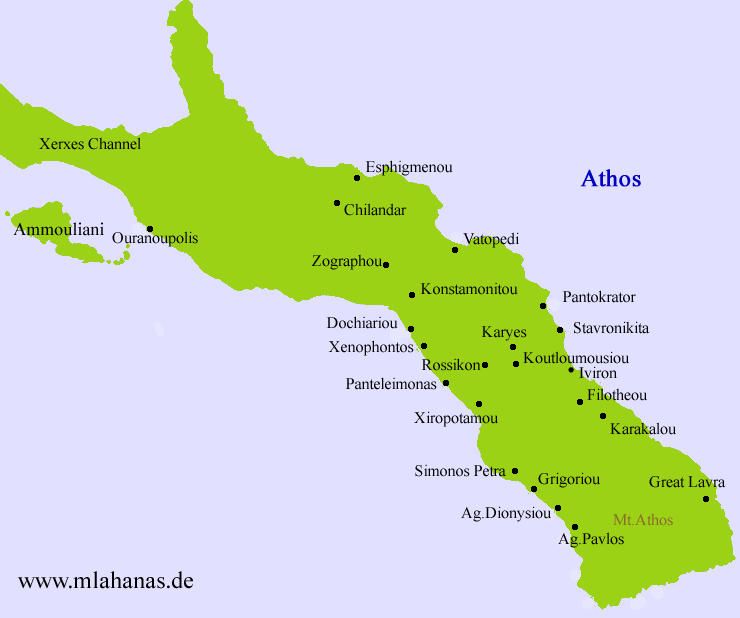
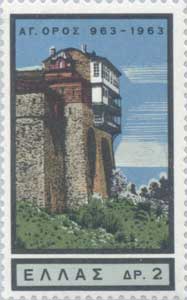
Stavronikita monastery (Greek: Μονή Σταυρονικήτα) is an Eastern Orthodox monastery at the monastic state of Mount Athos in Greece, dedicated to Saint Nicholas. It is built on top of a rock near the sea near the middle of the northeast shore of the Athonite peninsula, located between the monasteries of Iviron and Pantokratoros. The site where the monastery is built was first used by Athonite monks as early as the 10th century. Stavronikita was the last to be officially consecrated as an Athonite monastery in 1536 and ranks fifteenth in the hierarchy of the Athonite monasteries and currently has 30 to 40 monks
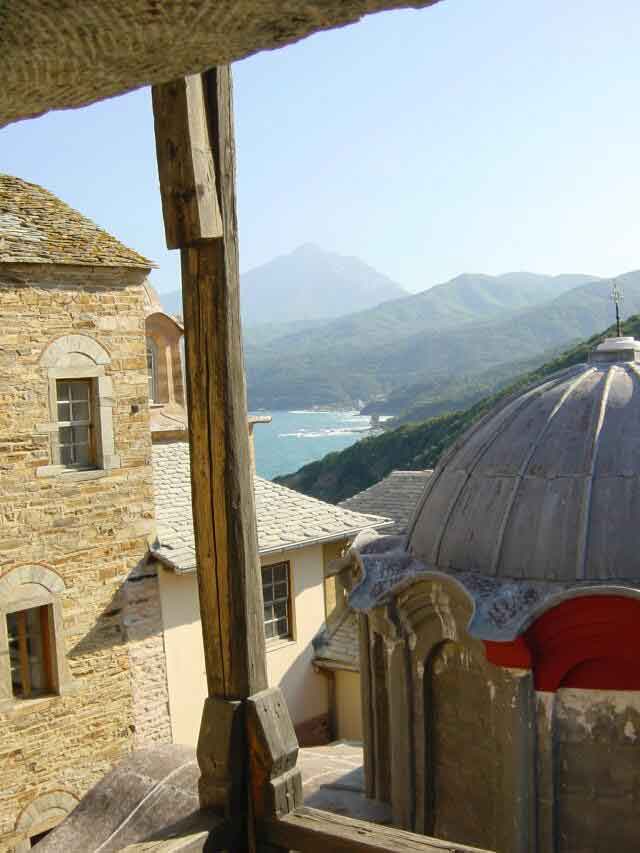
View from the interior of the monastery. At the background, the peak of Athos
Name
There are various conflicting traditions and stories regarding the monastery's name. According to one Athonite tradition, the name is a combination of the names of two monks, Stavros and Nikitas, that used to live in two cells at the site before the monastery was built. Another tradition recounts of a Byzantine army officer serving under the Byzantine Emperor John I Tzimiskes, named Niceforus Stavronikitas that built the monastery and named it after himself. Yet a third tradition attributes the foundation of the monastery to a patrician by the name Nikitas. The patrician's name day according to the Eastern Orthodox calendar of saints is celebrated the day after the Feast of the Cross. Hence according to this tale the monastery got its name by combination of the patrician's name with the word "Stavros" (the greek word for cross).
Apart from the traditional name, in some old documents the monastery is referred to as "Monastery of the Theotokos", which implies that the monastery was initially dedicated to the Theotokos. A more often encountered alternative name is "Monastery of Stravonikita" which is a corruption of the original name.
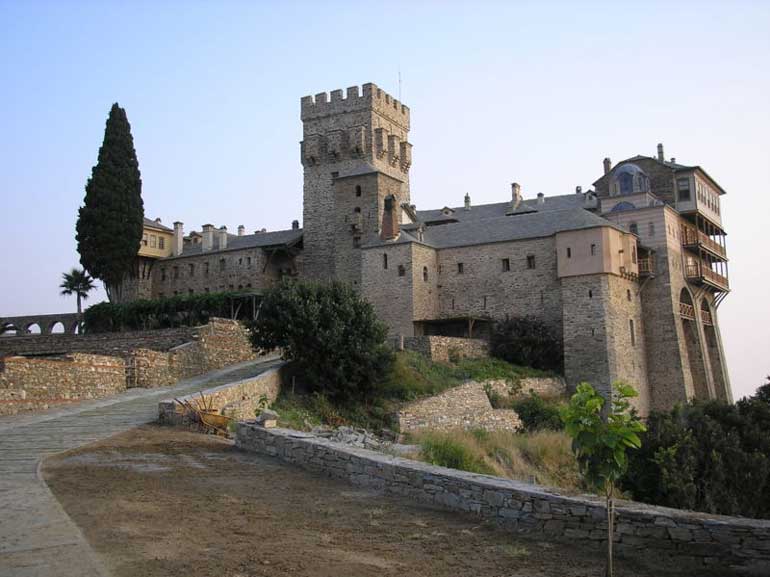
Stavronikita monastery at Mount Athos, Greece as seen from the South-East. Photo taken by Thodoris Lakiotis
History
The many conflicting tales of the monastery's name hint to the obscurity of its historical origins. In a document by the Protos Nikiforos dating back to 1012 there is the signature of a monk who signs as "Nikiforos monk from Stravonikita" (Greek: "Νικηφόρος μοναχός ο του Στραβωνικήτα"), while in a 1016 document, the same monk signs as "from Stavronikita"(Greek: "του Σταυρονικήτα"). This alludes to the existence of a Stavronikita monastery as late as the first half of the 11th century. According to archaeologist Sotiris Kadas this means that the Stavronikita monastery was one of the monasteries that were founded or built during the first years of organized monastic life on Mount Athos.[1]
This early part of the monastery's history ended approximately during the first half of the 13th century when the monastery was deserted due to constant pirate raids as well as due to the tremendous impact caused by the Fourth Crusade to the whole of the Byzantine Empire. The deserted monastery came initially under the jurisdiction of the Protos and later under the jurisdiction of Koutloumousiou monastery and later Philotheou monastery and functioned as a skete. In 1533, The monks of Philotheou sold Stavronikita to the abbot of a Thesprotian monastery, Gregorios Giromeriatis (Greek: Γρηγόριος Γηρομερειάτης). In 1536, a patriarchical edict by Patriarch Jeremias I reinstated Stavronikita's status as one of the monasteries of Athos, bringing their total number to 20. Therefore Stavronikita became the last officially consecrated monastery of Athos and is usually referred as the last monastery to be added to the athonite hierarchy
Gregorios Giromeriatis eventually left his monastery in Thesprotia and permanently settled in Stavronikita. In subsequent years he expended great efforts to rebuild and expand the monastery. He built a surrounding wall, many cells, as well as the monastery's catholicon. After the death of Gregorios in 1540, the renovation was continued by Patriarch Jeremias himself out of love and respect for Gregorios. An extraordinary feature of the monastery during this era is the fact that while most of the athonite monasteries had already largely adopted the so called "idiorythmic" lifestyle (a semi-eremitic variant of christian monasticism) , Stavronikita was founded and continued to function long after as on the principles of cenobitic monasticism.
The subsequent history of the monastery was marked by the fact that it always remained small in comparison to other athonite monasteries, both in property and in number of monks. Despite the repeated aid by the athonite community as well as by important benefactors, such as archon Servopoulos in 1612, the monk Markos in 1614, the people of Kea in 1628, Thomas Klados in 1630 and the Prince of Wallachia, Alexandru Ghica from 1727 to 1740, the monastery's evolution was constantly hampered partly by quarrellings with nearby sketes and monasteries, most notably with Koutloumousiou monastery, over matters of land property and more importantly by two great fires in 1607 and in 1741 that burnt Stavronikita to the ground. However the monastery continued to grow. In 1628 the catholicon was renovated and in 1770 the monastery's well-known aqueduct was built along with some of its chapels, such as the chapel of Saint Demetrius at the monastery's graveyard, the chapel of the Archangels and the chapel of the Five Martyrs.
During the Greek War of Independence in the early 19th century, Stavronikita, as well as the whole of Mount Athos, experienced harsh times. The monastery faced a harsh economic situation due to extraordinary debt that helped fund the war, while its monks were scattered after the Ottomans invaded Athos. Therefore the monastery, along with some other athonite monasteries, was deserted and so were many of its holdings in Wallachia, Moldavia and elsewhere. This situation lasted for about a decade, after which the Ottomans left Athos and any monks that had survived started returning to the monastery.
However, the monastery's prosperity was again endangered by three great fires in 1864, 1874 and 1879 that caused great damage. The monastery was rebuilt but the monks became largely indebted again which led to further decline. This situation was partly revered by the efforts of the abbot Theophilos, a monk formerly from Vatopedi.
![]()
Last Supper by Theophanes the Cretan
![]()
![]()
Crucifixion by Theophanes the Cretan
![]()
The Burial Lamentations by Theophanes the Cretan
Architecture
Stavronikita is the smaller in size among all the athonite monasteries. Important landmarks of the monastery are its trademark tower at the monastery's entrance, its aqueduct, as well as its centuries old cypress outside the western corner of the complex.
The catholicon of the monastery is dedicated to Saint Nicholas and is the smaller catholicon among its other athonite counterparts. It was built during the 16th century over a pre-existing church dedicated to the Theotokos. The catholicon is decorated with iconography by the famous iconographer Theophanes of Crete and his son Symeon. Apart from the catholicon, the monastery's refectory is located at the upper floor at the southern side of the complex and also bears some important iconography.
During the latter half of the 20th century the whole monastery complex had been largeley abandoned and was slowly falling apart. Additionally the rock on which the monastery is buit had been severely damaged by a series of earthquakes. The rock was found to be slowly crumbling and sliding towards the sea which lead to concerns about the future of the monastery's structural integrity.
The Center for the Preservation of Athonite Heritage (Greek: Κέντρο Διαφύλαξης Αγιορείτικης Κληρονομιάς, abbreviated Κε.Δ.Α.Κ.), a state organization under the jurisdiction of the Ministry for Macedonia–Thrace, undertook the task of renovating and restoring the monastery. Extensive renovating work took place from 1981 to 1999, while, utilizing a complex engineering method the underlying rock was stabilized.[2]
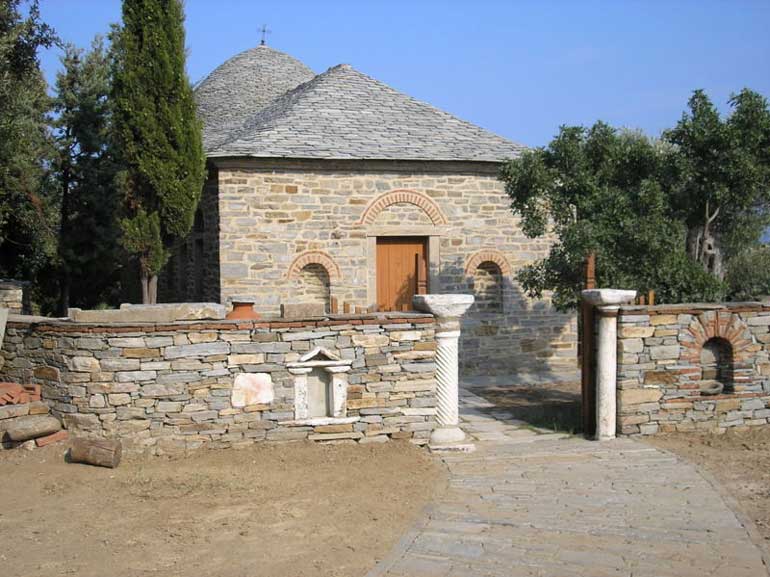
The chapel of Saint Demetrius at Stavronikita monastery at Mount Athos, Greece Photo taken by Thodoris Lakiotis
Cultural treasures
The monastery keeps a widely known 14th century icon of Saint Nicholas, known as "Streidas" (Greek: Άγιος Νικόλαος ο Στρειδάς, "Saint Nicholas of the Oyster") because when it was accidentally discovered at the bottom of the sea, an oyster had stuck at the forehead of St. Nicholas. According to the athonite tradition, when the monks of Stavronikita removed the oyster, the saint's forehead bled.
Stavronikita has a collection of notable icons and holy relics. The monastery also has in its possession priestly garments, ritual objects and other valuables. The monastery also has a collection of 171 manuscripts, out of which 58 are written on parchment. Some of the manuscripts bear notable iconography and decoration.
Footnotes
^ Kadas, Sotiris. The Holy Mountain (in Greek). Athens: Ekdotike Athenon, p.113. ISBN 960-213-199-3.
^ Center for the Preservation of Athonite Heritage page about Stavronikita, with photos of the stabilization of the rock.
Bibliography
Kadas, Sotiris. The Holy Mountain (in Greek). Athens: Ekdotike Athenon. ISBN 960-213-199-3.
Harkiolakis, Nikolaos. Tradition and Evolution of the Architecture of the Stavronikita Holy Monastery (in Greek). Mount Athos: Stavronikita monastery. ISBN 960-86507-0-4.
Links
Greek Ministry of Culture: Holy Monastery of Stavronikita
|
|||
|
Megistis Lavras · Vatopediou · Iviron · Hilandariou · Agiou Dionysiou · Koutloumousiou · Pantokratora · Xiropotamou · Zografou · Dochiariou Karakalou · Philotheou · Simonos Petra · Agiou Pavlou (St. Paul) · Stavronikita · Xenofontos · Grigoriou · Esphigmenou · Panteleimona (Rossikon) · Konstamoniti |
| Ancient Greece
Science, Technology , Medicine , Warfare, , Biographies , Life , Cities/Places/Maps , Arts , Literature , Philosophy ,Olympics, Mythology , History , Images Medieval Greece / Byzantine Empire Science, Technology, Arts, , Warfare , Literature, Biographies, Icons, History Modern Greece Cities, Islands, Regions, Fauna/Flora ,Biographies , History , Warfare, Science/Technology, Literature, Music , Arts , Film/Actors , Sport , Fashion --- |
Greece :
A - B - C - D - E - F - G - H - I - J - K - L - M -
N - O - P - Q - R - S - T - U - V - W - X - Y - Z
Retrieved from "http://en.wikipedia.org/"
All text is available under the terms of the GNU Free Documentation License


